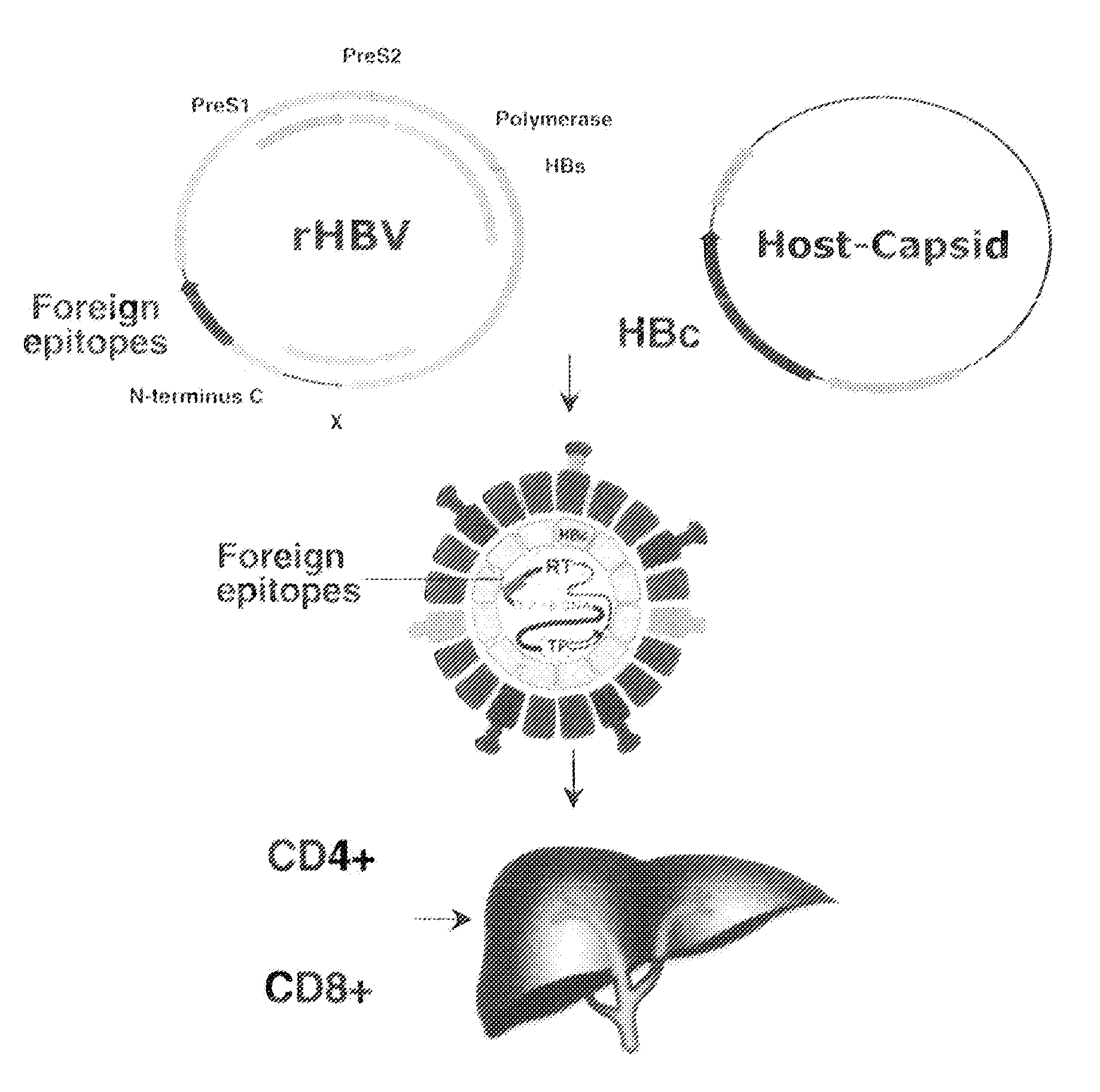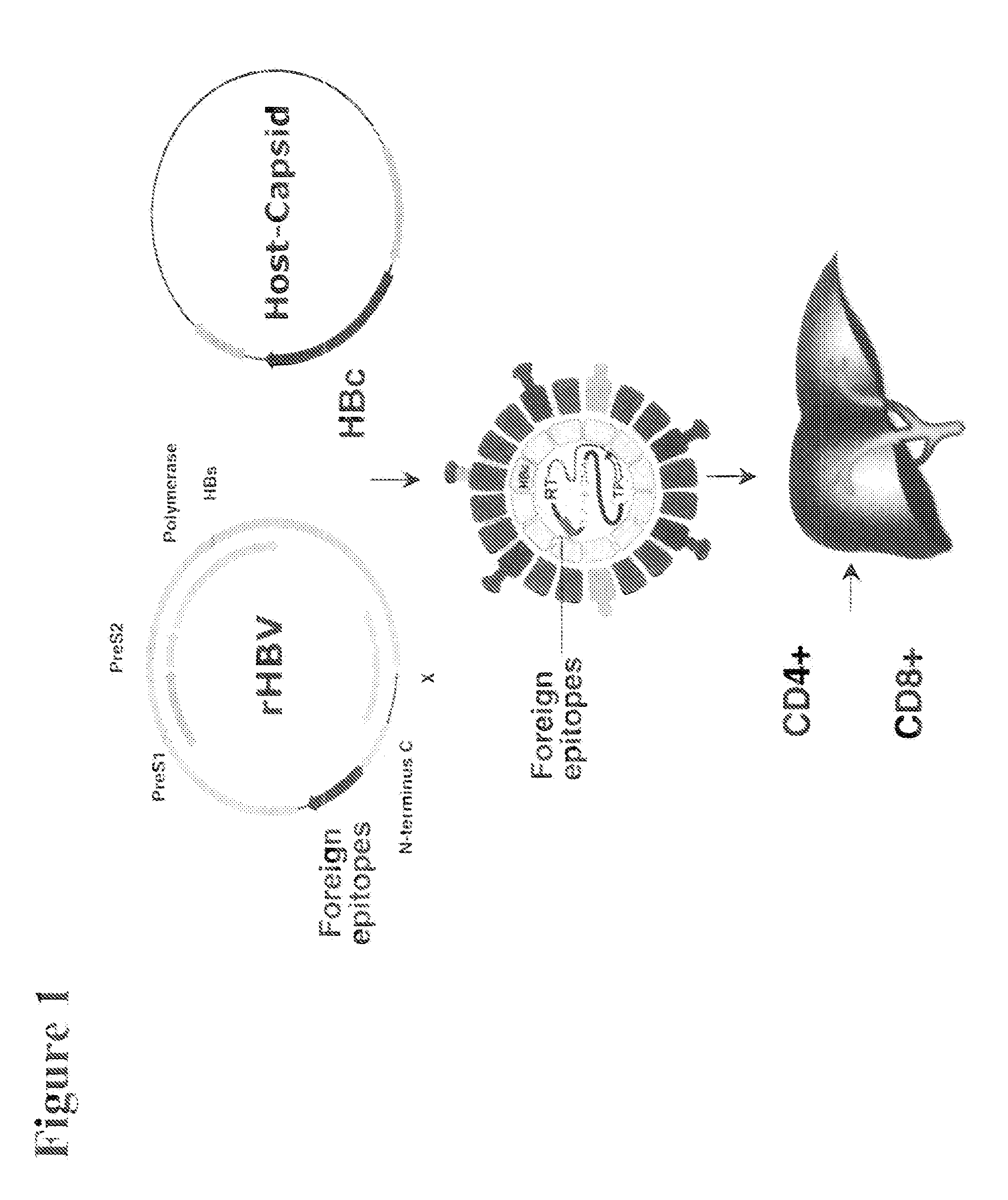Polynucleotides allowing the expression and secretion of recombinant pseudo-virus containing foreign epitopes, their production, and use
a technology of polynucleotides and pseudoviruses, applied in the field of polynucleotides allowing the expression and secretion of recombinant pseudoviruses containing foreign epitopes, their production, and use, can solve the problems of progressive decline followed by gradual decline, and achieve the effect of enhancing the activation sta
- Summary
- Abstract
- Description
- Claims
- Application Information
AI Technical Summary
Benefits of technology
Problems solved by technology
Method used
Image
Examples
example 1
In Vitro Assay for Recombinant HBV (rHBV) Replication
[0155]A polyepitope sequence was inserted into a 1.3 copy of HBV genome in the N-terminal part of the original capsid-encoding fragment to create the recombinant HBV (prHBV-1.3 and its derivatives-III or -IV, see FIG. 2). Co-transfection of prHBV1.3-III with the plasmid expressing capsid gene under a CMV promoter (pMAScore) to a liver cell line was carried out to initiate a replicating cycle mimicking the wild HBV replication in vitro (detection of cccDNA genome and other intermediate forms by Southern blot assay). Results are presented in FIG. 3A (detection of HBV genome in secreted viral particles by PCR).
[0156]The human hepatocytic cell line Huh7 (Nakabayashi, H., Taketa, K., Mlyano, K., Yamane, T., Sato, J. (1982) Growth of human hepatoma cell lines with differentiated functions in chemically defined medium, Cancer Res 42(9):3858-63) was transfected with prHBV1.3-III with or without pMAS-core, with pMAS-core alone, or with pFC...
example 2
In Vivo Assay for rHBV Infection
[0159]An investigation is made to determine whether the in vitro produced rHBV virion could be infectious in vivo. Since there is no small animal model, a UPA transgenic mouse with transplanted human liver tissue can be useful. (Morosan, S., et al. (2006) Liver-stage development of Plasmodium falciparum, in a humanized mouse model, J Infect Dis 193:996-1004.) For infection, a small stock of infectious rHBV is required. This will be obtained by first creating a stable HepG2 (ATCC number HB-8065) cell line expressing the rHBV genome constitutively and second by transducing this cell line with a lentiviral vector expressing the HBV core gene.
example 3
Creation of a String of Immunodominant Epitopes
[0160]Based on the knowledge of HBV molecular biology, the space to accommodate a foreign sequence in HBV genome is limited to more or less 195 nucleotides. Due to this space limitation, a short sequence encoding foreign immuno-dominant epitopes (polyepitope) is introduced into the recombinant HBV genome in order to induce a robust immune response. Regarding the polyepitope, it is arranged with 3 CD8+ T-cell epitopes combined with a promiscuous CD4+ T-cell epitope (PADRE), which could universally accommodate several prevalent MHC class II molecules. For the CD8+ T-cell response, considering the clinical relevance, three well known HLA-A2-restricted epitopes derived from common human viruses (HIV gag, Influenza matrix, EBV BML-F1) are chosen. Additionally, a short B-cell epitope (FLAG) is introduced into the foreign sequence as a convenient detection marker for molecular biology assays (see FIGS. 2 and 6). A HLA-A2-restricted capsid-deri...
PUM
| Property | Measurement | Unit |
|---|---|---|
| body weight | aaaaa | aaaaa |
| body weight | aaaaa | aaaaa |
| thick | aaaaa | aaaaa |
Abstract
Description
Claims
Application Information
 Login to View More
Login to View More - R&D
- Intellectual Property
- Life Sciences
- Materials
- Tech Scout
- Unparalleled Data Quality
- Higher Quality Content
- 60% Fewer Hallucinations
Browse by: Latest US Patents, China's latest patents, Technical Efficacy Thesaurus, Application Domain, Technology Topic, Popular Technical Reports.
© 2025 PatSnap. All rights reserved.Legal|Privacy policy|Modern Slavery Act Transparency Statement|Sitemap|About US| Contact US: help@patsnap.com



